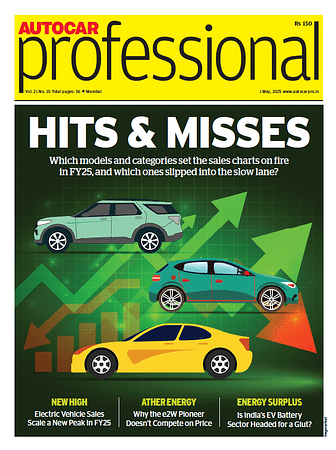Three-wheelers Lead India’s EV Push With Over 60% Market Share in April
The shift can be seen in other segments too. In the two-wheeler market, EV penetration grew from 3.97% to 5.44% year-on-year in April.
India’s shift from petrol, diesel, and CNG vehicles to electric mobility is picking up pace, with three-wheelers leading the charge. According to April 2025 retail data from the Federation of Automobile Dealers Associations (FADA), electric vehicles have gained over 60% market share in the three-wheeler market, marking the strongest EV adoption across all vehicle categories.
Electric three-wheelers' market share rose to 62.7% in April 2025 from 52.5% in the same month the previous year, and was even higher than March 2025’s 60%. The segment, which was heavily dependent on fuels like CNG and LPG, saw the combined market share of these gases drop from 34% in April 2024 to 25.9% in April 2025. This can be linked to the recent increase in CNG prices, which has significantly raised the total cost of ownership.
The Vahan data, too, showed an increase in electric three-wheeler sales by nearly 50% in April 2025 to 62,533 units compared to April 2024. The major players contributing to this growth are Mahindra Last Mile Mobility, YC Electric, Bajaj Auto, Saera Electric Auto, Dilli Electric Auto, and Piaggio Vehicles.
While internal combustion engine (ICE) vehicles still dominate, the steady rise in EV adoption, especially in three-wheelers, signals growing traction toward India’s 2030 goal of 30% EV penetration.
The transition is also underway in other segments. Two-wheelers, a high-volume market, saw EV penetration rise from 3.97% to 5.44% year-on-year in April. However, this is a drop from 8.65% in March, largely due to reduced government subsidies.
Policy changes have played a role in the decline of electric two-wheeler adoption in April. Under the PM-eDrive scheme, the subsidy for electric two-wheelers was halved to Rs 2,500 per kWh, capped at Rs 5,000 per vehicle from April 2025. The broader Rs 10,900 crore budget scheme also covers e-buses, trucks, ambulances, and charging infrastructure, and is set to run until March 2026.
In the passenger vehicle segment, the EV share increased from 2.26% to 3.5% in April 2025 but slipped slightly from 3.54% in March, reflecting a small decline in overall car sales.
Commercial vehicles and tractors, meanwhile, remain diesel-heavy. EVs account for just about 1% in the commercial vehicle segment, while diesel still holds complete share in tractors.
While EV adoption in other segments is not as high as in three-wheelers, the drop in ICE fuels is noticeable. For instance, the petrol-ethanol mix in passenger vehicles fell to 50% in April, down three percentage points from last year. In two-wheelers, it declined to 94% from 96% in the same period.
RELATED ARTICLES
India-UK Free Trade Agreement to Boost Auto Sector
The deal opens up massive export opportunities for labour-intensive industries and key sectors such as engineering goods...
Indian EV Market Faces Challenges as Subsidies Decline in April 2025
The reduction in PM E-DRIVE subsidies has created short-term challenges, particularly for E2Ws, but the report expects t...
Luminis Collaborates with Forvis Mazars in India to Expand Microbiome-Based AgTech Solutions
The partnership aims to support Luminis’ expansion into India’s soil microbiome and aquaculture sectors, facilitated by ...






 By Yukta Mudgal
By Yukta Mudgal
 06 May 2025
06 May 2025
 729 Views
729 Views





 Kiran Murali
Kiran Murali


 Arunima Pal
Arunima Pal

 Sarthak Mahajan
Sarthak Mahajan

